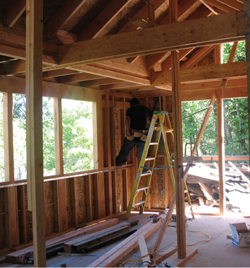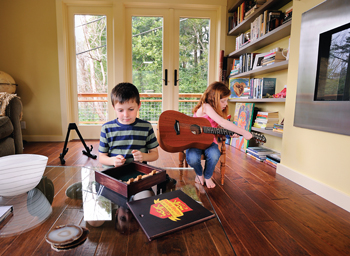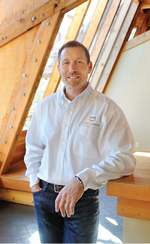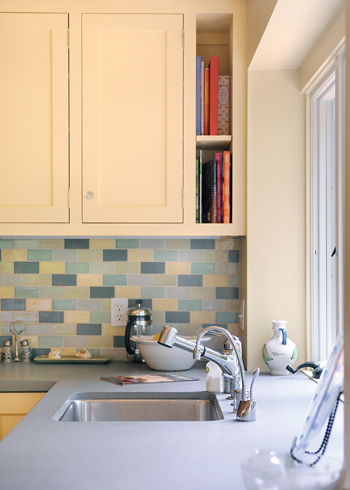During the now-busted housing bubble, when all you needed to qualify for a $100,000 remodeling loan was a pulse, when cable channels were crammed with home makeover shows, when “shelter porn” magazines proffered fantasies of tricked-out master bedroom suites, we chanted the mantra of Veruca Salt, the gum-chewing girl in Willy Wonka and the Chocolate Factory: “I want it, and I want it now!”
That was so then. Today, money is tight, loans hard to come by. Luxurious self-indulgence is history, replaced by back-to-basics maintenance. Those who can get a home improvement loan are mostly ignoring the tingling allure of sexy kitchens and settling for the more sedate satisfaction of reshingled (and perhaps greener) roofs.
Jim and Michelle Doty of Corte Madera got caught smack dab between the two eras. When they decided to redo their 1,800-square-foot fixer-upper in Chapman Park, they expected the usual remodel speed bumps—delays, overruns, contractors missing in action—but they never worried about money. After all, their loan from Washington Mutual came through without a snag.
In March 2008, though, with demolition well under way and the Dotys and their two children encamped in a rented apartment in Larkspur, their remodeling dream turned into a financial nightmare. Without notice, Washington Mutual pulled their home equity loan—and the Dotys became victims of the banking industry collapse.
Initially, Jim Doty figured it was a simple mistake, easily correctable. Wrong. First, no one at the Washington Mutual branch in Corte Madera wanted to deal with the situation. Then, he got the runaround on the phone. “I tried to rationalize with a dispassionate customer service rep over the phone, (pointing out) that seeing the construction through was in both of our best interests,” says Doty, but all he got was a fax number—and no name—where he could send photos of the project and a copy of the contractor’s agreement. It seemed futile. Even the Dotys’ mortgage banker told them to get another loan.
At one point, Michelle Doty cast aside all pride and made a tearful visit to the bank. “The whole thing was very emotional, and sadly eye opening. I actually believed that banks cared.” she says. “I couldn’t believe they could just take the money back. Jim tried to convince me that it wasn’t personal, it was just a spreadsheet—but it was still so frustrating.”
Fortunately, the Dotys’ contractor was as sympathetic as the bank was callous. “You’re the second client this week,” he said upon hearing the news. But he continued working on the Dotys’ home.

The whole ugly affair ended as bureaucratically as it started. Just a half-day before the Dotys were going to sign a new (and more expensive) loan, a form letter arrived by mail from Washington Mutual. Their original loan was reinstated.
Today, the Dotys are enjoying their remodeled home, complete with the customized personal touches they envisioned before the project began—a fireplace, for example, whose river stones evoke backcountry memories of one of their favorite places, Yosemite. The financial meltdown is morphing from painful memory to dinner-party anecdote.
The Dotys’ home is likely not worth as much as it would have been a couple of years ago and it might take longer to recoup their investment, but, says Jim, “although, the ROI may be longer than we thought it would be when we started the project, we love our new home.” Agreed, adds Michelle. “We go to bed every night feeling grateful.”
Remodeling, 2009 Style
Dawn and Josh Denberg, who live with their two children in Corte Madera not far from the Dotys, are remodeling veterans. They are starting the journey the Dotys have finished—and it will be their third home makeover. This time, though, cash is at a premium and they are sorting out what they have to do from what they want to do.
The couple’s first remodel was a house in Sycamore Park 12 years ago. It got the full treatment—high-end kitchen and bathroom that would mean money in their pocket if they had to sell. Later, taken to Chicago for work, they recovered all their expenses and then some.
Today, back in Marin and living in a comfy but dated home on Baltimore Avenue in Larkspur, they are taking a different tack. No more large construction company. They opted for a single contractor who does his own electrical and plumbing. They downsized their plans.
“Instead of opening up the wall of the kitchen to the family room, we are splurging on a cherry-red Big Chill refrigerator,” Dawn says. “And in terms of going green, we are switching out the wood-burning for direct-vent fireplaces and putting in bamboo floors.” She’s also “keeping a vanity in our master bath that I’m not crazy about. It wouldn’t cost too much to replace it, but then it just ends up in landfill. Keeping it just feels more sustainable, for the environment as well as financially.”
Just as the Dotys were part of one trend, the Denbergs are members of another—the less-is-more approach to remodeling.
Fix-it Projects on the Rise
A study this year by the Joint Center for Housing Studies at Harvard University found that during the housing boom “Americans invested in discretionary home improvements as a wealth-building strategy.” In other words, we spent money on big remodels, knowing that rising home prices would recover the cost. Now, with housing values falling, even in Marin, the study found “owners are more likely to make improvements primarily to maintain the structural integrity and efficient functioning of their homes.”
“Homeowners are focusing on the more necessary improvements and replacements,” says Abbe Will, a researcher for the study, “particularly to the home’s exterior and systems including plumbing, electrical, heating, and cooling systems, as well as the routine maintenance and repairs that simply keep the home in good working order.”
That sort of maintenance is on the rise in Marin, builders say, in part because most homes here were built decades ago—right after World War II (Sycamore Park, Belveron), during the 1950s (Bel Aire, Marinwood, Strawberry) and the 1960s (parts of Peacock Gap, Bel Marin Keys). Leaking windows, corroded pipes and cranky heating systems are strong incentives to remodel.
The demand for “fix-it” jobs is so high that longtime Marin builder Caletti Jungsten Construction has created a division that specializes in home updates and maintenance. “With so many customers asking us to help with minor upgrades, we created a separate part of our business tailored to these jobs,” says co-owner Jeff Jungsten.
Jungsten is also seeing a significant increase in the number of people who want to use a green solution in their fix-it projects. “It’s actually cheaper in the long run, because it saves money,” he says. “People like it for both social and economic reasons.”
Indeed, green projects are reshaping the remodeling economy, says Harvard’s Will. “The remodeling downturn will be much less drastic than what we’ve already seen in the home-building industry,” she says, partly because “homeowner interest in green building and energy-efficiency is growing (and) will provide some buffer during this down market.”
Leverage for Buyers
For the first time in decades, homeowners have the negotiating advantage with contractors. “Right now demand (for contractors) is down because of the economic fears and the banks tightening up loans and credit lines,” says Klif Knoles, general manager of the Marin Builders Association.
So “if you’ve got the money, now is a great time to move forward on those remodeling plans. Contractors are more competitive these days and (the cost of) raw materials is lower,” says Knoles. “Where we used to see two or three general contractors bidding competitively, we now see many more than that bidding on the same project.”
One of those contractors is Denny Kasten of Kasten Builders of Novato, who says for the first time in his multi-decade career he is looking for clients rather than relying on word-of-mouth referrals. “If you have the money, homeowners will get the absolute best service,” he says. “Contractors are going to have to start making money the old-fashioned way: by giving customers the best possible service, which includes fair pricing and getting the best available subs on their jobs.”
Jungsten, of Caletti Jungsten, agrees. “It’s the best buyer’s market I’ve ever seen,” he says. “And I’ve been doing this for 30 years.”
CAPTION: (middle, top) Framing stage of living room. (middle, bottom) Doty children play on the hand-scraped hickory and radiant-heated floors in their new living room. (bottom) Jeff Jungsten of Caletti Jungsten.

Mimi Towle has been the editor of Marin Magazine for over a decade. She lived with her family in Sycamore Park and Strawberry and thoroughly enjoyed raising two daughters in the mayhem of Marin’s youth sports; soccer, swim, volleyball, ballet, hip hop, gymnastics and many many hours spent at Miwok Stables. Her community involvements include volunteering at her daughter’s schools, coaching soccer and volleyball (glorified snack mom), being on the board of both Richardson Bay Audubon Center. Currently residing on a floating home in Sausalito, she enjoys all water activity, including learning how to steer a 6-person canoe for the Tamalpais Outrigger Canoe Club. Born and raised in Hawaii, her fondness for the islands has on occasion made its way into the pages of the magazine.


